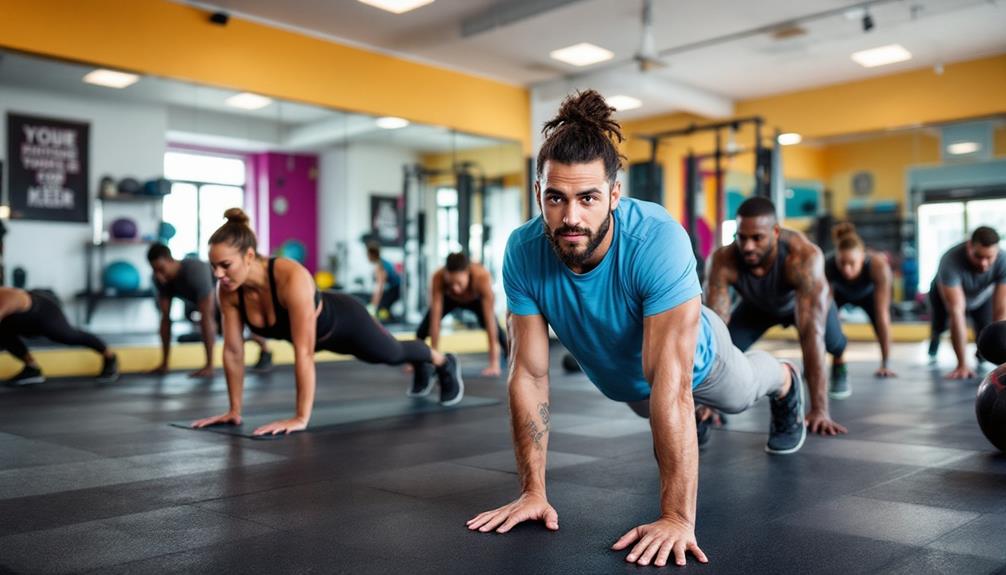Core resistance training is pivotal for building a strong torso and enhancing stability. Start with fundamental exercises like planks, which stabilize your core, and crunches, focusing on upper abs. It's essential to use proper techniques; align your body and control your movements. To maximize workouts, vary your exercises regularly, and consider using resistance tubes for additional challenge. Tracking your progress will keep you motivated, so maintain a workout journal and adjust your routine as needed. Pay attention to recovery, too, with stretching and foam rolling. There's plenty more to explore in effective training strategies.
Core Insight
- Begin with essential core exercises like planks, crunches, and Russian twists to build a stable fitness foundation.
- Focus on proper technique to ensure effective engagement of core muscles and prevent injuries.
- Incorporate resistance tubes to vary intensity based on your fitness level and control movements for better results.
- Track progress in a workout journal, set clear goals, and regularly adjust your routine to maintain motivation and improvement.
- Utilize infrared heat therapy and foam roller exercises to aid recovery, reduce soreness, and enhance flexibility.
Understanding Core Resistance Training

Core resistance training is important for building a strong base in your fitness routine. This type of training focuses on strengthening the muscles around your torso. This helps provide stability and support for your entire body. Using compression sleeves can help support your muscles during core exercises. They improve blood flow and reduce fatigue.
Core resistance training is key for improving overall performance, posture, and lowering the risk of injury.
Essential Core Exercises

A strong core comes from doing exercises that target your abdominal, back, and pelvic muscles. Start with planks to stabilize your core and build strength. Then, add crunches to work on your upper abs. Russian twists will help strengthen your obliques, which are important for twisting movements. For your lower back, try supermans; these strengthen your lower back and glutes. Bridges are great for activating your glutes and engaging your core. Finally, bicycle crunches combine cardio and core work, hitting multiple muscle groups.
If you often experience muscle fatigue or soreness, consider using compression sleeves for extra support and quicker recovery. Aim for a balanced routine that includes all these exercises to work different areas of your core. Consistency is important; with regular practice, you'll see improvements in your stability and overall strength.
Proper Techniques for Effectiveness

To get the most out of core resistance training, it's important to focus on proper technique. Start by aligning your body. Keep your back straight and engage your core during each exercise. This helps prevent injuries and makes your workout more effective. When choosing resistance tubes, pick ones that fit your fitness level and goals. These tubes come in different colors, indicating weights from 2 lbs to over 40 lbs, which allows for progressive training.
Next, control your movements. Take your time with each repetition. Performing exercises slowly and deliberately increases tension on your muscles, which helps build strength.
Also, remember to breathe correctly. Exhale when you exert yourself and inhale during the relaxing phase. This breathing pattern keeps your body oxygenated and enhances your performance.
Tips for Maximizing Workouts

To get the most out of your workouts, it's important to maintain good technique. Pay attention to your breathing; exhaling when you exert yourself can help you perform better. Change up your exercises to work different muscle groups and keep things interesting. Using infrared heat therapy before or after your workout can ease muscle soreness and improve your flexibility, which can boost your overall performance.
Mix both compound and isolation exercises in your routine for a well-rounded approach. Make sure you're lifting the right weights; using weights that are too heavy can cause injuries, while weights that are too light won't challenge you enough. Consistency is key; sticking to a regular workout schedule helps you build strength and endurance. Always warm up before your workout and cool down afterward to support recovery.
Lastly, listen to your body. If something doesn't feel right, don't hesitate to make changes to your routine. Small adjustments can lead to big improvements in your performance.
Progress Tracking and Adjustments

Tracking your progress is essential for improving your core resistance training. It helps you understand what works and where you need to make changes. Here's an easy way to keep track of your progress:
- Keep a Workout Journal: Write down your exercises, sets, reps, and weights. You can also add foam roller exercises to improve flexibility and help with muscle recovery.
- Set Clear Goals: Decide what you want to achieve, like boosting your strength or endurance.
- Check Your Form: Regularly review your technique to avoid injuries and make sure your workouts are effective.
- Change Your Routine: If you stop seeing progress, switch up your exercises, increase your weights, or adjust your sets and reps.
Frequently Asked Questions
How Often Should I Perform Core Resistance Training Each Week?
You should aim to perform core resistance training about two to three times a week. This frequency allows your muscles to recover while still challenging them, promoting strength and stability effectively over time.
Can Beginners Safely Start Core Resistance Training?
Yes, you can safely start core resistance training as a beginner. Focus on proper form, start with lighter weights, and gradually increase intensity. Listen to your body, and don't hesitate to seek guidance if needed.
What Equipment Is Necessary for Core Resistance Workouts?
To build a strong core, you'll need equipment like resistance bands, dumbbells, or stability balls. Think of them as the tools in your fitness toolbox, helping you sculpt and strengthen your core effectively.
Are There Any Dietary Tips to Complement Core Training?
To complement your core training, focus on a balanced diet rich in lean proteins, healthy fats, and plenty of fruits and veggies. Staying hydrated and timing your meals around workouts can also boost your performance.
How Can I Prevent Injuries While Training My Core?
Did you know that 80% of people experience back pain at some point? To prevent injuries while training your core, focus on proper form, warm up, and listen to your body's signals during workouts.

